Within the program, discussion about the benefits of alfalfa production and use are integrated. This results in participants realizing that alfalfa has a potential as a forage crop because of the combination of new cultivars, better nutrient management techniques and marketing opportunities for the region.
Alfalfa requires high phosphorus (P) and potassium (K) soil fertility and has a high demand for these nutrients. Alfalfa removes large amounts of nitrogen (N) and K from the field when harvested as hay and also has the ability to draw down nitrate levels within its root zone, thus decreasing nutrient runoff and leaching potential. Manure, particularly poultry litter, is high in P and K and micronutrients such as boron. Proper applications of poultry litter to alfalfa can provide sufficient quantities of required nutrients without overloading the soil profile.
Poultry production was the top agricultural commodity in Mississippi for 2016, grossing nearly $2.3 billion in sales and ranking fifth in the nation. Poultry has been the leading commodity in Mississippi for over 20 straight years. Poultry litter, a mixture of manure, feathers and bedding material, is a valuable source of plant nutrients and organic matter of great interest to many livestock and row-crop farm managers across Mississippi and remains the most sustainable option for disposal.
For forages, linking dry matter (DM) production with litter utilization can be a difficult, yet effective, approach for addressing both the problems associated with manure disposal and reducing impact on the environment. Often times, poultry litter is the most economical and most available source of fertilizer in Mississippi.
As alfalfa acreage across Mississippi and the Deep South increases, information regarding fertility management in this crop is crucial in helping new farmers produce economically sustainable forage. This project seeks to bridge this knowledge gap by evaluating the impacts of poultry litter on alfalfa production in Mississippi.
Trials
A field trial was established in the fall of 2017 in Newton, Mississippi (Coastal Plain Branch Experiment Station [CPBES]; see Photos below), where data was collected across two growing seasons (2018 and 2019). This trial compared poultry litter with traditional commercial fertilizer, across three cultivars: Bulldog 505, Bulldog 805 and AlfaGraze 600RR.
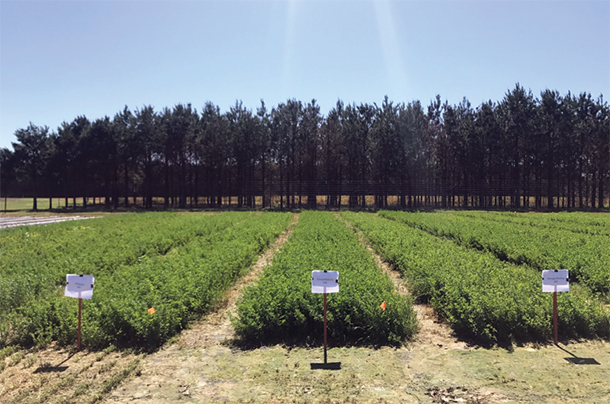
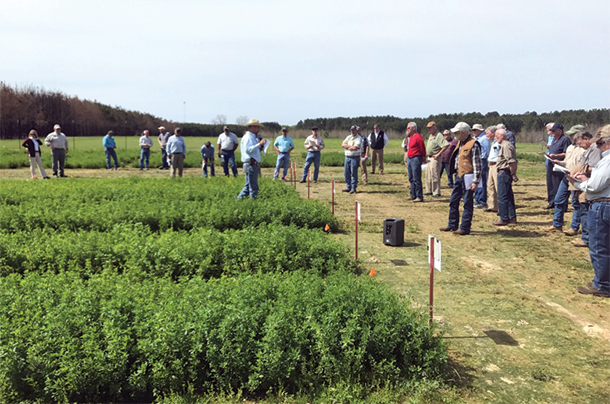
Fertilizer treatments included two rates of poultry litter (1 and 2 tons per acre) and two commercial treatments (one used the same amount of N, P and K as the litter analysis – positive control, and the other was the same P and K but no N was applied – negative control). Treatments were applied in split applications: once prior to harvests in the spring and again after the third harvest each year. DM yield, along with stand persistence (crown counts) and nutritive value, was analyzed. Six harvests were conducted in 2018 and, as of the date of this writing, five harvests have been conducted in 2019.
Cumulative DM yield was analyzed to determine the effects of year, harvest, cultivar and fertilizer treatment (Table 1).
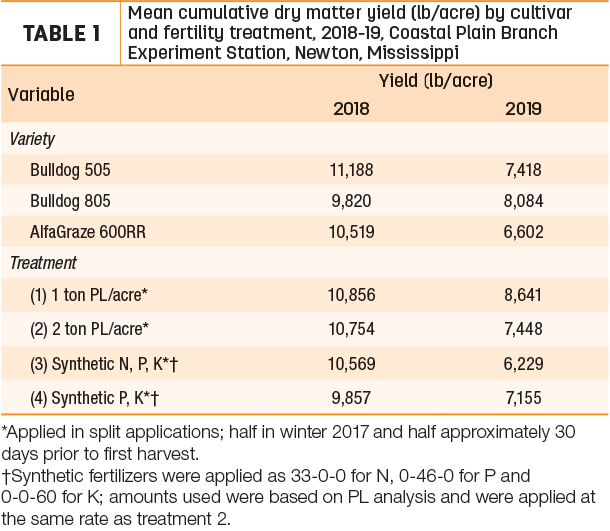
No differences were observed by cultivar or fertilizer treatment for cumulative DM yield. Forage nutritive value was measured for each plot at each harvest (Table 2).
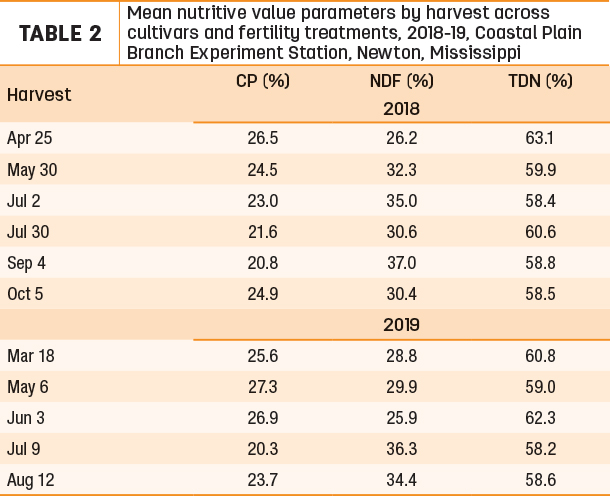
Samples were dried, ground and analyzed using near-infrared reflectance spectroscopy (NIRS) to determine crude protein (CP), acid detergent fiber (ADF), neutral detergent fiber (NDF), fat, lignin and mineral concentrations. Total digestible nutrients (TDN) were calculated based on these results.
For CP, no differences were observed by cultivar or fertilizer treatment. Mean CP values were above 20% for all harvests. Differences were observed by cultivar for NDF. Both conventional cultivars had lower NDF concentrations than AlfaGraze 600RR in several harvests. Finally, for TDN, differences were again observed by cultivar and fertilizer treatment.
Along with agronomic productivity, an economic comparison (cost per ton) was also made between cultivars and fertilizer treatments (Table 3).
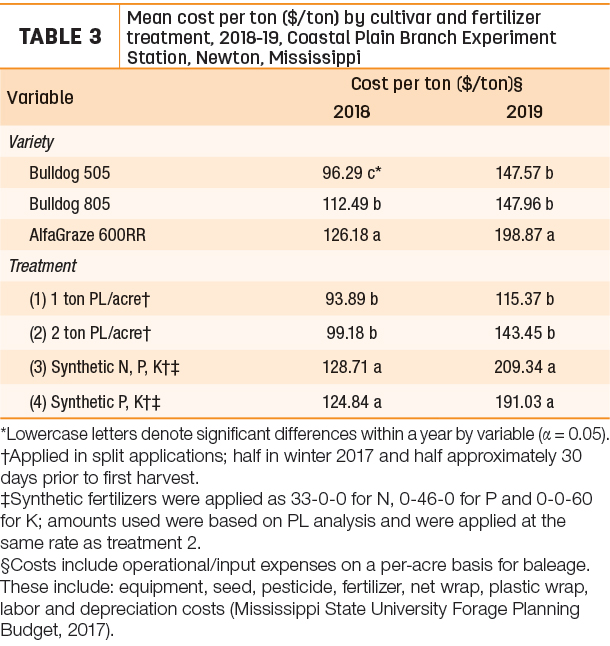
These comparisons were made based on the assumption that operators were producing alfalfa and preserving it in the form of baleage.
In the South, producing quality dry alfalfa hay can be extremely difficult due to environmental conditions required for dry curing. Baleage allows producers to quickly ensile alfalfa, thus preserving the highest-quality feedstuff and reducing the risk associated with curing. Prices used in these cost estimates include equipment, seed, pesticide, fertilizer, plastic wrap, labor and depreciation costs obtained from the Mississippi State University Forage Planning Budget, 2017.
Results
In 2018, Bulldog 505 had the cheapest cost per ton ($96.29). In 2019, both conventional cultivars had cheaper cost per ton compared to the Round-up Ready cultivar. In terms of fertilizer treatment, the two poultry litter sources were cheapest per ton in both years of the study. The obvious trend in increasing cost between years is a direct result of decreased DM yields realized in the second year of the trial.
There was a 30% to 40% reduction in yield in the second year of the trial. For most research trials and production fields assessed in Mississippi, this decrease in the second year is typical, with nearly a 50% reduction in DM yield observed by year three.
This project is part of an ongoing effort to generate essential data while simultaneously educating producers, government agencies and the private industry on the potential of alfalfa production in Mississippi. Based on results from the 2018 and 2019 growing seasons, Bulldog 505 has the potential to generate high DM yields with lower costs compared to the other cultivars tested. Costs and soil fertility assessment should be the primary factors in determining a nutrient management plan for alfalfa production.
In terms of forage nutritive value, alfalfa can produce much higher-quality feedstuffs than traditional hay species in the Deep South. Crude protein values above 20% and TDN values of well over 50% are much better than traditional high-quality bermudagrass hays. Based on producer response, more information regarding management and cultivar selection (especially long-term data) is needed to increase producer acceptance and market adoption.
Continued efforts, in terms of field trials and fertility management, will enable forage specialists to more accurately deliver recommendations. Also, soil analysis will more thoroughly determine the effects of poultry litter application on nutrient build-up and removal. ![]()
PHOTO 1: Alfalfa poultry litter field trial taken on April 4, 2018, at Newton location.
PHOTO 2: Coastal Plain Forage Field Day hosted on April 5, 2018.
Brett Rushing is the lead researcher from Mississippi State University on this project and is collaborating with Rocky Lemus, also at MSU.

-
J. Brett Rushing
- Coastal Plain Branch Experiment Station
- Newton, Mississippi
- Email J. Brett Rushing











